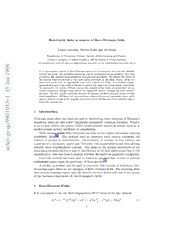Table Of ContentRelativistic disks as sources of Kerr-Newman fields
Toma´ˇs Ledvinka, Martin Zˇofka and Jiˇr´ıBiˇca´k
DepartmentofTheoretical Physics,FacultyofMathematics andPhysics,
CharlesUniversity,VHoleˇsoviˇcka´ch 2,18000Prague8,CzechRepublic
ledvinka@mbox.troja.mff.cuni.cz,zofka@otokar.troja.mff.cuni.cz,bicak@mbox.troja.mff.cuni.cz
8
9
9 If an appropriate region of Kerr-Newman space-time is removed and suitable identifi-
1 cations are made, the resulting space-time can be interpreted as an infinitely thin disk
producingtheoriginalelectromagnetic andgravitational fields. Wechoosetheshapeof
n
the regions removed in such a way that radial pressures in the disks vanish. Even the
a
very inner parts such as ergoregions may exist around the disks. The surface energy-
J
momentumtensorofthedisksischeckedtosatisfytheweakandstrongenergyconditions.
5 Toemphasize the realityof these sources twomodels of thedisks arepresented: (i)ro-
1 tating conductive charged rings which are supported against collapse by their internal
pressure, (ii) two counter-rotating streams of charged particles moving along circular
1 electro-geodesics. Allthesedisksourcesformathree-dimensionalparameterspacewith
v specificelectricchargeQ/M,angularmomentuma/M andthesizeoftheexcludedregion
3 beingtheparameters.
5
0
1 1 Introduction
0
8
Although much effort has been devoted to discovering exact solutions of Einstein’s
9
/ equations,there areonlya few”physicallyacceptable”solutionsavailable. Whatis
c
in particular lacking are sources which would produce numerous known vacuum or
q
electrovacuum metrics burdened by singularities.
-
r MostvacuumstaticWeylsolutionscanariseasthemetricsofcounter-rotating
g
: relativistic disks1,2. The method used to construct such sources resembles the
v
method of images in electrostatics. Alternatively, it consists in first cutting out
i
X a portion of a stationaryspace-time ”between”two hypersurfaces andthen glueing
r suitably these hypersurfaces together. The jump in the normal derivatives of the
a
resultingpotentialsinducesamatterdistributioninthediskwhicharisesduetothe
identification. Onehasthentoanalyzewhetherthematterisphysicallyacceptable.
Later the method has been used to construct physical disk sources of vacuum
stationary space-times, in particular, of Kerr metrics3,4.
A similar procedure can be used to construct disk sources of stationary elec-
trovacuumspace-timesas,for example,ofKerr-Newmanfields. The resulting disks
thencontainrotatingmatterandalsoelectriccurrentswhichariseduetothejumps
of the (normal components of) electromagnetic fields.
2 Kerr-Newman Fields
It is convenient to use the Weyl-Papapetrou(W-P) form of the line element
ds2 =e−2ν e2ζ(d̺2+dz2)+̺2dϕ2 e2ν(dt+Adϕ)2, (1)
−
(cid:2) 1 (cid:3)
with the simple relation to Boyer-Lindquist(B-L) coordinates
z =(r M)cosϑ, ̺= r2 2Mr+a2+Q2sinϑ. (2)
− −
Regarding these relations, functions ν,ζp,A entering the metric can be found from
the standard form of the K-N metric in B-L coordinates.
In the W-P coordinates we exclude the region z [ b,b]. Using then the
∈ −
formalismforthin shells5 which cancarryanelectric charge6, we find that the disk
has no radialpressure and the surface stress-energytensor and electric currentcan
simply be expressed in terms of the derivatives of the metric and electromagnetic
potentials at z =b (indices a,b correspond to t,ϕ)
√g̺̺ gab
S = , (3)
ab
8π g
(cid:18) ̺̺(cid:19),z
1
J = (A ) . (4)
a −2π a ,z
Theexistenceofdraggingresultsinanon-diagonalstress-energytensor. Thefollow-
ingtwomodels ofthediskareconsidered. Inthefirstmodelthediskis constructed
from rings with internal pressure. The necessary condition is that S can be di-
ab
agonalized, i.e., one can find, at any radius, ϕ-isotropic observer (FIO) who sees
only energy density and azimuthal pressure. In the charged case the rings are also
charged and conduct a current to form the current density J .
a
In the second model the disks are described as two counter-rotating streams
of freely moving charged particles. The fact that in the static case their velocities
mustbeidenticalandopposite,allowsonetofindV± =± Sϕϕ/Stt. Whendragging
is present, the stream velocities Ua must be determined from the geodesic (or the
±
p
electro-geodesic) equation
1
2ǫ±gab,(̺)U±aU±b =−σ±F(̺)cU±c. (5)
Although Sab has three different components, the Einstein and contracted Gauss-
Codazzi equations guarantee that the following decompositions can be made
Sab =ǫ+U+aU+b +ǫ−U−aU−b, (6)
Jα =σ+U+a +σ−U−a. (7)
3 Properties of the disks
The centralmass densities and the centralelectric chargedensities of the disks can
be expressed in analytic forms
M (b+M)2 a2 Q2(1+b/M)
ǫ = − − , (8)
c 2π[(b+M)2+a2]3/2[b2+a2 M2+Q2]1/2
−
Q (b+M)2 a2 (b+M)2+a2
σ = − . (9)
c 2π[(b+M)2+a2]2sb2+a2+Q2 M2
−
2
Other physical properties of the disks can be best exhibited graphically. Here we
limitourselvestopresentjustoneexamplecorrespondingtothe diskproducingthe
Kerr-Newman gravitational and electromagnetic fields with M = 1, a = 0.4 and
Q = 0.1. In the figures the disks with b/M = 0.912,1.0,1.1,1.2,1.3,1.4,1.5 are
considered. The disk with b/M = 0.912 cannot be constructed from the counter-
rotating streams, even though it satisfies both the weak and strong energy con-
ditions. The disks become highly relativistic in central regions but they all have
”classical” properties at large R (proper circumferential radius). The mass and
chargedensities(asmeasuredbyFIOs)decreaserapidlywithR. Thediskshavein-
finite extensions, their total mass, charge,and angular momentum are finite. They
should have properties common with finite relativistic disks. And they represent
the only physical sources of Kerr-Newmanfields available today.
0
2 0
. .
0 1
.15 0.8
0
6
.
0 0
1
.
Mε 0 V.4
0
5
0
0. .2
0
0 0
0 0.5 1 1.5 2 2.5 3 0 1 2 3 4 5 6
R/M R/M
Figure 1. Radial distribution of mass Figure 2. Velocity of FIO with respect
density as seen by FIO to LNRF and the ratio of azimuthal
pressure to mass density (dashed)
0.08 -3.10
5
.
6 2
0
0. .0
2
εM+-0.04 σM+-1.5
0
.
2 1
0
0. .5
0
0 0
0 0.5 1 1.5 2 2.5 3 0 0.5 1 1.5 2 2.5 3
R/M R/M
Figure 3. Distribution of mass density Figure 4. Distribution of charge density
in both streams ǫ+ and ǫ− (dashed) in both streams σ+ and σ− (dashed)
References
1. J. Biˇca´k, D. Lynden-Bell, and J. Katz, Phys. Rev. D 47, 4334 (1993).
2. J. Biˇca´k, D. Lynden-Bell, and C.Pichon, MNRAS 265, 126 (1993).
3. J. Biˇca´k and T.Ledvinka, Phys. Rev. Lett. 71, 1669 (1993).
4. C. Pichon and D. Lynden-Bell, MNRAS 280, 1007 (1996).
3
5. W. Israel, Nuov. Cim. 44, 1 (1966); 48, 463 (1967).
6. K. Kuchaˇr,Czech J. Phys. B 18, 435 (1968).
4

